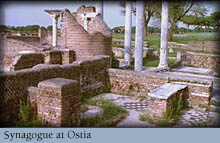
It was the Emperor Claudius (41-54 CE) who first enlarged the sheltered harbor called Portus nearby. In the second century Trajan (98-117 CE) further expanded the shipping capacity by dredging out and constructing a second, inner harbor. In Ostia itself, one finds numerous warehouses and market buildings lining the riverfront whart area. Another characteristic element of Ostian architecture is the numerous apartment buildings, shops, and tavernas that line the main streets, especially in the densly packed areas around the central Forum, the religious and administrative heart of the city.
Ostia's commercial and shipping interests produced a rich and cosmopolitan city. Adjacent to the theater is the Forum of the Corporations, a large open air market complex where shipping agencies from cities all across the empire had booking offices. Most of these shops have floors richly decorated with scenes of their hometowns, harbors, and ships. In the center of the courtyard of the Forum stands a temple dedicated to Ceres, the Roman goddess of grain and vegetation. Perhaps more than any other commodity that passed through its warehouses, grain and other foodstuffs were the basis of the city's wealth and fame, for Ostia provided the food supply for the nearly one million people that packed the city of Rome. Grain from Egypt, olives and oils from North Africa, wines from Gaul -- all flowed into Rome through Ostia.
With these far-flung shipping networks Ostia also attracted a diverse population, just as we see in Rome itself. One of the important recent archaeological discoveries to illuminate this aspect of Ostia's life is the presence of a Jewish synagogue discovered in 1960. The synagogue building is located near the ancient shoreline on the southwest side of the city, just outside the ancient city walls.
The building faced onto the main road, called the Via Severiana, that ran from Ostia and Portus down the coast to the south. In use from the second to the early fifth century CE, the builidng reflects the social life of a local Jewish congregation. At one point the growth of the congregation apparently made it necessary for them to renovate and enlarge the synagogue building in the third and fourth centuries CE. The nature of these renovations show that the congregation did not feel threatened by living in pagan society, and the edifice was embellished in the high architectural style of the day. In the hall of assembly, however, new architectural elements reflect the particular nature of Jewish liturgy, with an apsidal Torah Shrine for using of the sacred scrolls during worship. Each architrave of Torah Shrine is graced with a carved menorah relief, and an inscription gives further testimony to the centrality of Torah in their religious life.
Finally, because it was such an important waystation in route to Rome, Ostia was the scene of some early Christian activity. Although there is no direct archaeological evidence of Christian buildings prior to the fourth century CE, one of the important Christian apologies was set in Ostia. The Octavius of Minucius Felix was written in the form of a dialogue between a pagan and a Christian and begins as they stroll through the town of Ostia. Later, Ostia was the home for a time of Augustine, later the famous bishop of Hippo in North Africa. Ostia was also where Augustine's mother, Monica, lived in her later years. Augustine describes affectionately in his Confessions how he chose to bury her in Ostia rather than transport her body back to North Africa for burial in a family tomb. Another pious Christian later dedicated a memorial to Monica there as a result of the role she plays in Augustine's life as depicted in the Confessions.